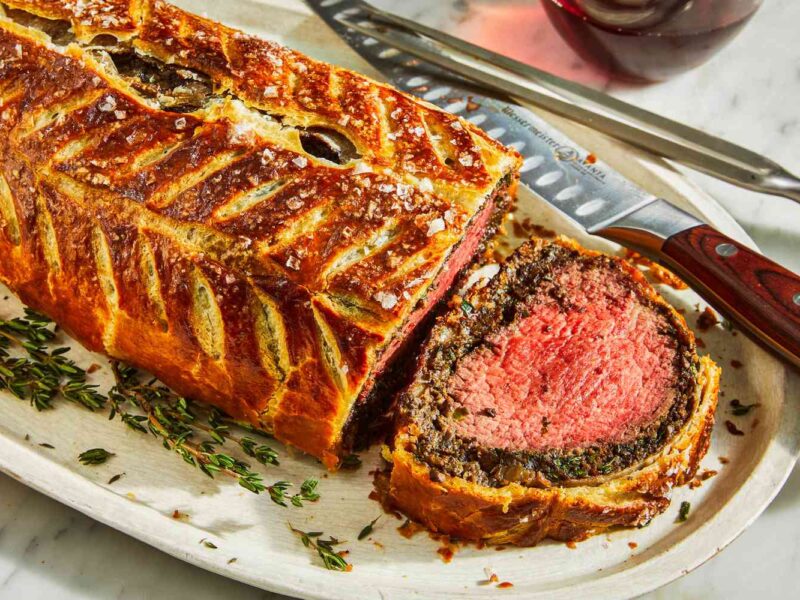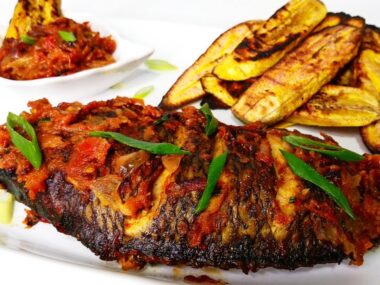Beef Wellington stands as an epitome of culinary excellence, revered for its luxurious combination of tender beef fillet, savoury mushroom duxelles, and buttery puff pastry. This iconic dish has its roots in British cuisine, with its origins tracing back to the 19th century. Beef Wellington has since evolved into a symbol of sophistication and indulgence, gracing the tables of fine dining establishments and home kitchens alike. This essay embarks on a gastronomic exploration of Beef Wellington, delving into its rich history, intricate preparation, and irresistible allure.
History and Origins
The precise origins of Beef Wellington are shrouded in culinary lore, with several theories attributing its creation to various historical figures and events. One popular narrative suggests that Beef Wellington was named in honour of Arthur Wellesley, the 1st Duke of Wellington, a celebrated British military leader who defeated Napoleon at the Battle of Waterloo in 1815. According to this account, the dish was conceived as a culinary tribute to the Duke’s victory and his fondness for beef and mushrooms.
Another theory posits that Beef Wellington may have been inspired by French haute cuisine, particularly the classic dish “filet de boeuf en croûte” (beef fillet in pastry). The adoption of puff pastry and mushroom duxelles in Beef Wellington reflects the influence of French culinary techniques on British gastronomy during the 19th century.
Ingredients and Preparation

Beef Wellington is characterized by its exquisite combination of premium ingredients meticulously layered to create a symphony of flavours and textures. The key components of Beef Wellington include:
- Beef Fillet: The heart of Beef Wellington, the beef fillet, is prized for its tenderness and flavour. Ideally, a centre-cut portion of beef tenderloin is used, trimmed and tied to ensure uniformity in shape and cooking.
- Puff Pastry: Encasing the beef fillet is a layer of flaky puff pastry, which provides a delicate and buttery crust. Puff pastry is traditionally made by layering butter between thin sheets of dough, then folding and rolling the dough to create hundreds of layers that puff up during baking.
- Mushroom Duxelles: A savoury mixture of finely chopped mushrooms, shallots, garlic, and herbs, mushroom duxelles serve as a flavorful bed for the beef fillet. The mushrooms are sautéed until they release their moisture and develop rich umami flavours, creating a luxurious filling for Beef Wellington.
- Prosciutto: Thin slices of prosciutto or Parma ham are often used to wrap the beef fillet before layering it with mushroom duxelles. The prosciutto adds a subtle saltiness and richness to the dish while helping to seal in the juices of the beef.
- Egg Wash: A simple egg wash made from beaten eggs and water is brushed over the puff pastry before baking, giving the crust a glossy golden finish.
Preparation of Beef Wellington is a labour of love, requiring precision and attention to detail to ensure each component is executed flawlessly. The beef fillet is seared to seal in its juices and develop a rich caramelized crust, then cooled before being wrapped in prosciutto and mushroom duxelles. The puff pastry is rolled out into a thin sheet, enveloping the beef fillet and its flavorful filling, then sealed and decorated with decorative patterns or cuts.
Cooking and Serving
Once assembled, Beef Wellington is baked in a preheated oven until the puff pastry is golden brown and crisp, and the beef fillet reaches the desired level of doneness. The internal temperature of the beef should register at least 130°F (54°C) for medium-rare or higher for those who prefer their meat more well-done.
Beef Wellington is often served with a rich gravy made from the pan drippings of the seared beef, fortified with beef stock, red wine, and aromatic herbs. The gravy adds depth and intensity to the dish, complementing the succulent beef and savoury pastry.
Traditionally, Beef Wellington is sliced into thick portions and served with a generous ladle of gravy, accompanied by side dishes such as roasted potatoes, steamed vegetables, or buttered greens. The unveiling of Beef Wellington at the dining table is a moment of anticipation and delight, as guests marvel at the golden-brown crust and savoury aromas wafting from the tender beef within.
Conclusion
In conclusion, Beef Wellington epitomizes the artistry and refinement of classic cuisine, blending premium ingredients with meticulous preparation to create a dish that is as visually stunning as it is delicious. From its intriguing origins steeped in history to its intricate layers of flavours and textures, Beef Wellington captivates the senses and ignites the palate with each sumptuous bite.
Whether enjoyed in an upscale restaurant setting or prepared with care in the comfort of one’s home kitchen, Beef Wellington remains a timeless masterpiece that continues to inspire and delight gastronomes around the world. As diners savour the luxurious combination of tender beef, savoury mushroom duxelles, and buttery puff pastry, they embark on a culinary journey that celebrates the art of fine dining and the enduring legacy of a culinary classic.










